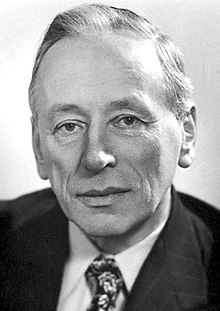Frits Zernike
Frits Zernike | |
|---|---|
 Frits Zernike (1888-1966) | |
| Born | July 16, 1888 |
| Died | 10 March 1966 (aged 77) |
| Nationality | Netherlands |
| Alma mater | University of Amsterdam |
| Known for | Ornstein-Zernike equation Zernike polynomials Phase contrast microscopy |
| Awards | Rumford Medal (1952) Nobel Prize for Physics (1953) |
| Scientific career | |
| Fields | Physics |
| Institutions | Groningen University |
| Doctoral students | Christoffel Bouwkamp Herman de Boer Bernard Nijboer |
Frits Zernike (July 16, 1888 – March 10, 1966) was a Dutch physicist and winner of the Nobel prize for physics in 1953 for his invention of the phase contrast microscope, an instrument that permits the study of internal cell structure without the need to stain and thus kill the cells.
Biography
Zernike was born in Amsterdam, Netherlands to Carl Frederick August Zernike and Antje Dieperink. Both parents were teachers of mathematics, and he especially shared his father's passion for physics. He studied chemistry (his major), mathematics and physics at the University of Amsterdam. In 1912 he was awarded a prize for his work on opalescence in gases. In 1913 he became assistant to Jacobus Cornelius Kapteyn at the astronomical laboratory of Groningen University. In 1914, he was responsible jointly with Leonard Salomon Ornstein for the derivation of the Ornstein-Zernike equation in critical-point theory. In 1915, he obtained a position in theoretical physics at the same university and in 1920 he was promoted to full professor of theoretical physics.
Research in physical optics
In 1930, Zernike was conducting research into spectral lines and discovered that the so-called ghost lines that occur to the left and right of each primary line in spectra created by means of a diffraction grating, have their phase shifted from that of the primary line by 90 degrees. It was at a Physical and Medical Congress in Wageningen in 1933 that Zernike first described his phase contrast technique in microscopy. He extended his method to test the figure of concave mirrors. His discovery lay at the base of the first phase contrast microscope, built during World War II.
Another contribution in the field of optics is related to the efficient description of the imaging defects or aberrations of optical imaging systems like microscopes and telescopes. The representation of aberrations was originally based on the theory developed by Ludwig Seidel in the middle of the nineteenth century. Seidel's representation was based on power series expansions and did not allow a clear separation between various types and orders of aberrations. Zernike's orthogonal circle polynomials provided a solution to the long-standing problem of the optimum 'balancing' of the various aberrations of an optical instrument. Since the 1960s, Zernike's circle polynomials are widely used in optical design, optical metrology and image analysis.
Zernike's work helped awaken interest in coherence theory, the study of partially coherent light sources. He died in hospital at Amersfoort, Netherlands in 1966 after suffering illness the last years of his life.[1]
Honours and awards
Zernike has an Erdős number of six.[2] The university complex to the north of the city of Groningen is named after him (Zernike park), as is the crater Zernike on the Moon. Zernike's great-nephew Gerardus 't Hooft won the Nobel Prize in physics in 1999.[3]
See also
- Leonard Salomon Ornstein
- Coherence theory
- Physical optics
- Phase contrast microscope
- Zernike polynomials
- Oz Enterprise (a Linux distribution named after Leonard Salomon Ornstein and Frederik Zernike).
References
- ^ Van Berkel, Klaas (1999). "Frits Zernike 1888-1966". A History of Science in The Netherlands. Survey, Themes and Reference. Leiden: Brill. pp. 609–611. ISBN 9004100067.
{{cite book}}: Unknown parameter|coauthors=ignored (|author=suggested) (help) - ^ Jerry Grossman (22 April 2008). "Some Famous People with Finite Erdös Numbers". The Erdös Number Project. Archived from the original on 2008-06-18. Retrieved 2008-07-15.
- ^ Robert Goldwyn. "Gerardus 't Hooft Science Video Interview".
External links
- Frits Zernike Photo
- Frits Zernike Biography
- "How I discovered phase contrast" Nobel Prize speech
- Extended Nijboer-Zernike theory
- Museum Boerhaave Negen Nederlandse Nobelprijswinnaars
- H. Brinkman, Zernike, Frits (1888-1966), in Biografisch Woordenboek van Nederland.
- Prominente Groningse hoogleraren Frits Zernike (1888-1966)
- Frits Zernike (1888-1966) biography at the National library of the Netherlands.
- The Ornstein-Zernike equation and integral equations
- Multilevel wavelet solver for the Ornstein-Zernike equation Abstract
- Analytical solution of the Ornstein-Zernike equation for a multicomponent fluid
- The Ornstein-Zernike equation in the canonical ensemble
